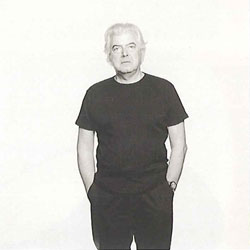José de Guimarães
José de GuimarãesGuimarães ¶ 1939
 |
|
| Créditos fotográficos / Photographic credits: Abílio Leitão |
He graduated in Civil Engineering at IST. In 1958, he took up painting and drawing classes with Teresa de Sousa and Gil Teixeira Lopes, and a printing course at SCGP. Between 1961 and 1966 he travelled through Europe and, between 1967 and 1974, he was stationed in Angola serving with the arm. Nevertheless he became entangled with the international aesthetic propensities of the 60s, its discourses and practices, especially the colour exuberance of pop art, which the artist would tie in with Angolan cultural archetypes. ¶ Influenced by native African art, but enhancing it with a simultaneously erudite and Western dimension, the artist was able to create a subtle alliance between the "comedy" and the "tragedy" of human life, progressively de-dramatizing his compositions until he reached the stage of centring the cultural matrix of European painting in his "motifs-series" (Kings, The Lovers, The Painter and the Model, the Circus, Sports, and Portuguese Landscapes). ¶ After moving to Antwerp in 1976, his work began to achieve international recognition, specifically with his Rubens homage series. In 1978 he created a very peculiar Alfabeto de Símbolos (Alphabet of Symbols), which became a source for formal-symbolical references. For instance, the "pseudo-sculptures" he developed in 1980, made from thick, granulated paper, would draw from that "coded vocabulary" a panoply of forms, with a noteworthy impact at a signical level. They generate a bodily synthesis with an optimistic Biomorphism in which colour has an essential compositional role. ¶ Inspired by the essentialist tendencies of Eastern spirituality, the author integrated in his oeuvre formal stereotypes from other cultures (Mexican, Japanese), always involving them in a dialogue with Western artistic contexts, from primitive art to a Picassoan modernism. ¶ In the 90s, after opening up his work to themes such as death and spiritual reflection, as well as rather Informalism - and materialism - influenced values, the artist's oeuvre was finally at the centre of national recognition, with retrospectives at the Serralves and the Gulbenkian foundations, as well as several interventions in public spaces, both abroad and at home. One of the most important events was the 2004 exhibition at the Cordoaria Nacional, at which a minutely detailed catalogue-book was published.
View the embedded image gallery online at:
http://cvc.instituto-camoes.pt/biografias-en/jose-de-guimaraes-dp1.html#sigFreeId51611324d0
http://cvc.instituto-camoes.pt/biografias-en/jose-de-guimaraes-dp1.html#sigFreeId51611324d0


